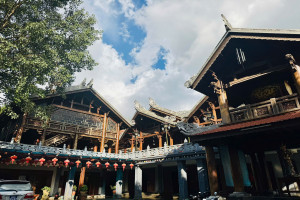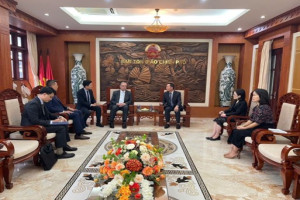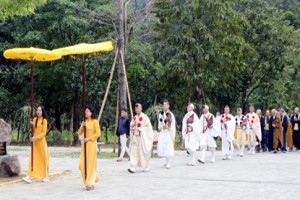
Cambodia’s Ministry of Environment Developing Buddhist Cultural Center at Kirirom National Park
01/23/2024
Cambodia’s Ministry of Environment is developing a meditation site of Dharma practice at the Buddhist Cultural Centre of Cambodia, located inside Kirirom National Park, Kampong Speu Province. The objective is to encourage local and visiting Buddhists to practise meditation and to gain a better understanding of the Buddha’s teachings.
Visual plan of the Buddhist Cultural Center Of Cambodia. Image from Google
On 6 January, minister of the Ministry of Environment Eang Sophalleth visited the site and stated that it is designed to purify the mind, resulting in tranquillity and happiness. “We’re creating a special space for Buddhists to meditate, featuring modern Khmer tents that stand out from the rest,” said Sophalleth. “This place is destined to become a legacy for the next generation of Cambodian children. For our trial phase, we plan to set up five to 10 tents.” (Asia News Network)
The Ministry and Department of Environment in Kampong Speu province actively engaged in the planting of tens of thousands of plants on the centre’s grounds, in line with the religious culture’s emphasis on natural forests. According to Sophalleth, the combined objectives of fostering Buddhist culture and highlighting natural resources is consistent with his ministry’s Circular Strategy on Environment 2023–28. The strategy attempts to transfer the environmental sector’s potential into practical benefits for Cambodia and its people.
Construction site of the new Buddhist Cultural Centre within Kirirom National Park in Kampong Speu province. Photo from Asia News Network
The yet-to-be-completed Buddhist Cultural Centre, which spans 126 hectares, has been operating since 2005. Its stated purpose is to promote Buddhism, uphold societal values, and develop national culture. Former prime minister Hun Sen supported the establishment of the institute. The location is home to the spectacular Pathom Chedi temple, a large stupa measuring 108 meters in length and 37 meters in width, and it said to house the Buddha’s relics along with various sacred texts. Intricate stone sculptures in the center’s compound reflect key periods of the Buddha’s life, such as his birth and enlightenment. A stunning 84,000 Buddha sculptures have also been carved from natural rock and placed in the center.
Sophalleth emphasized the Ministry’s objective of promoting environmental stewardship in communities. He believes there is a link between conservation efforts and improved livelihoods, since the center intends to improve the lives and prospects of local residents.
“In various nations, Buddhist centres have stood for centuries. As Khmer practitioners of Buddhism, it is fitting for us to have our own centre,” said the founder of the centre, Venerable Nhek Buntha. “I consider it a national treasure, initiated with generosity despite not possessing hundreds of millions of dollars. The participation of the Queen Mother and individuals from diverse backgrounds underscores the broad support for this initiative.” (The Phnom Penh Post)
According to Sun Meanchey, director of the Kampong Speu Culture and Fine Arts Department, “. . . this centre stands as a remarkable achievement and is positioned to emerge as a prominent cultural and religious tourism destination, given its immense size and significance.” (The Phnom Penh Post)
Chhort Bunthang, a research fellow at the Royal Academy of Cambodia, also praised the project, citing the site’s fresh air and richness of natural beauty. “In our advanced society, people today face numerous mental challenges. This meditation space serves as a remedy, purifying hearts and minds to address these issues,” said Bunthang. “It plays a role in boosting tourism, as Cambodian and international tourists support the products sold by nearby residents.” (Asia News Network)
Source: buddhistdoor.net/Dipen Barua






